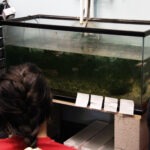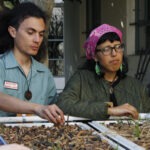As the bright afternoon sun filtered through the leaves, a gaggle of PCC students gathered in a loose circle in the garden space between the C and L buildings. Before the meeting even started, food was the topic. Two attendees recognized each other and talked about an organic supermarket where they both used to work. Another commented on how high its prices are, then the discussion turned to gentrification and food availability in low-income areas. Later, a question about PVC piping led to sharing kale chip recipes. Throughout the workshop, the talk always came back to food.
The meeting on Feb. 25 was the first aquaponics workshop put on by the PCC student club Formerly Incarcerated Radical Scholars Team (FIRST). FIRST is a student group dedicated to community-building among people who have been affected by the prison system. It addresses issues of environmental justice, education, prison reform and, at this workshop especially, food justice. FIRST is using the community garden as a teaching tool for gardening skills and a hub for organizing and involvement. A lot of time and effort have gone into it already, but it is still a work in progress. They hope that a small piece of nature on campus will attract people and encourage them to help make the garden better.
Jasmine Lopez, FIRST’s student coordinator, talked about her history with food.
“I grew up gardening,” said Lopez. “My grandpa had a huge garden in the backyard of our house. I’d never thought about how privileged we are to have the food we have, but we don’t have direct access to growing our food.”
FIRST took on responsibility for the small plot of land between C and L in the summer of 2019. Since then they have been building it into a space where the club and community can gather.
“We just got the garden cleaned up, we just built the aquaponics system from the ground up,” said Lopez. “[We want this] to be a safe space, to be out in nature for our mental health, our physical health and creating food for people who don’t have food access.”
Michael Grey, a specialist in sustainable agriculture, led this introductory workshop. He is a Pasadena community member who has been working with FIRST since the project started. He explained that both the name and the science of aquaponics derive from a combination of aquaculture and hydroponics.

A Hydroponic tank that is located and maintained in 201-N. This hydroponic tank feeds several types of algae.
“Hydroponics is growing plants without any soil,” said Grey. “The concept is you’re using water to have nutrients flow to the plants instead of soil. You have a reservoir that’s full of water and you add agriculture chemicals to that: your nitrogens, your phosphates, all the things that plants need.”
Growing plants hydroponically requires far less water and space than growing them in soil. It also grows them very quickly and offers a great deal of flexibility in the physical layout of the garden.
“Aquaculture is just growing any animal in water,” Grey said, “so that’s fish, snails, shrimp, crab, lobster, all that kind of stuff. You can grow a lot of fish in a small area, [but] there is a lot of waste. You’ve got to deal with the fish poop. What are we going to do with the fish poop?”
Ammonia-rich fish waste has to be filtered out and removed or it will sicken the fish and contaminate the soil and water around it.
Aquaponics combines these two systems so that the waste from the fish becomes food for the plants. But that requires one more crucial ingredient: bacteria.
“We’re trying to recreate a river ecosystem. Without the river bacteria the aquaponics system would not work.” Grey explains.
These kinds of bacteria are everywhere—in the soil, plumbing systems, floating around in the air—quietly breaking down ammonia and other nitrogen-rich compounds into the nitrates that plants need.
Today, aquaponics systems use a wide range of modern materials and equipment. The system at PCC includes large plastic grow trays, PVC piping, clay pellets and soon, solar panels. However, the technique was developed a long time ago.
“This is not new technology, this has been used for many thousands of years,” said Grey. “The people in what is now known as Mexico City were using something called chinampas and that’s a very early form of aquaponics. They essentially created islands in the rivers and canals and they used what was already there to grow their food. They were able to feed a city of over 200,000 every year, so they were very successful at that.”
Dr. Nicholas Hatch is a professor of nutrition at PCC and faculty advisor to FIRST’s garden project. Initially he was just a willing sponsor but soon he saw that the project fit into his holistic approach to nutrition, including FIRST’s emphasis on social justice. His biggest desire for the garden is to get more people involved.
“I’d love it to be a shining example of how anyone can get involved with a project,” said Dr. Hatch. “Everyone brings something to the table. It doesn’t matter who you are on this campus. And I say the same thing in nutrition. It doesn’t matter what you want to ultimately do, you have a role to play in better nutrition. We need lawyers to advocate, we need artists to spread the word and tap into people’s emotions and get them thinking about these things. We also need people in agriculture and sciences and nutrition, we need people in business. If you have an interest in food you can grow your role, and I think the garden can be an example of that to the campus community.”

Attendee’s Gabriel Valdez and Lou Fuentes at the Community garden on February 26.
Dr. Hatch emphasized that the community he talks about goes beyond the students and staff of PCC.
“Pasadena City College is not just for the students, it’s for the community. It’s a community college and part of our mission is to better the community and to go out into the community and form partnerships with community members. It’s not PCC in a silo.”
One of those community members is self-described maker and gardening enthusiast Sunrise the Divine. He has been helping to build the PCC system after working on the very large aquaponics operation at the University of California in Santa Barbara (UCSB). He said that just finding out about aquaponics at UCSB inspired him to get into farming and the “blueprints of life.”
“I’ve just been here helping as much as I can and learning as much as I can,” said Sunrise. “I probably couldn’t tell it to you on paper, but if we were stuck on an island and we had some resources I could probably whip up a little something!”
When the organizers were asked what would help FIRST and the community garden most, one answer stood out: involvement. All skill levels and backgrounds are welcomed. A lot of the work that needs to be done is just cleaning up the space, pulling weeds and checking on the equipment.
“There is a role for everyone here,” said Dr. Hatch.
The hope is that FIRST’s community garden will be not only an on-campus refuge but a working garden producing food for the Lancer Pantry. Students and community members will be able to learn skills that have sustained human life for thousands of years.
“We got another generation ahead of us and we should be able to do this for them,” said Sunrise. “We’re going to be grandparents someday and we got to get some good home-cooked meals.”
FIRST will hold further workshops on aquaponics and gardening every month. The next one will be Mar. 24 in the garden. More information about FIRST can be found at their Instagram account, @firstpcc.
- Congressman Schiff promotes $3 trillion ‘HEROES Act’ at virtual town hall - May 27, 2020
- ‘Pain in the ass’: PCC exasperated by federal stimulus rules - April 29, 2020
- PCC’s dash to catch up to COVID-19 - March 25, 2020
